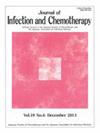日本血吸虫感染伴维生素B12缺乏1例
IF 1.5
4区 医学
Q3 INFECTIOUS DISEASES
引用次数: 0
摘要
绦虫病是一种绦虫感染,与食用生的或未煮熟的鱼有关。在人类绦虫感染的致病病原体中,日本海二bothriocephalus nihonkaiensis是第二大流行物种,每年造成2000多例人类感染病例。虽然日本海蚊主要分布在北太平洋地区,但最近在世界其他地区(包括美国)也报告了几例病例。由于担心日本血吸虫感染的进一步传播,准确诊断和了解相关并发症至关重要。虽然人们普遍认为,作为人类双叶螺旋体病的主要致病物种之一,牛双叶螺旋体偶尔会伴有维生素B12缺乏症,但据我们所知,日本海螺螺旋体维生素B12水平下降的病例尚未见报道。然而,由于绦虫和绦虫在1986年之前并没有被区分开来,因此应仔细讨论由绦虫引起的维生素B12缺乏问题。我们在此报告了日本第一例分子证实的与维生素B12缺乏症相关的日本血吸虫感染。该病例为一名19岁男性,无明显既往病史。患者在食用生鳟鱼2个月后出现绦虫排泄。初次就诊时,他的实验室数据显示维生素B12水平略有下降;然而,没有注意到贫血。两个月后,他的维生素B12水平进一步下降;然而,在驱虫药治疗后,它会自发消退。本病例为日本血吸虫感染的临床表现提供了有价值的见解。本文章由计算机程序翻译,如有差异,请以英文原文为准。
Dibothriocephalus nihonkaiensis infection accompanied with vitamin B12 deficiency: A case report
Diphyllobothriosis is a tapeworm infection and is associated with the consumption of raw or undercooked fish. Among causative pathogens of human tapeworm infection, Dibothriocephalus nihonkaiensis is the second most prevalent species, contributing to over 2000 cases of human infection annually. Although D. nihonkaiensis is primarily distributed in the northern Pacific region, several cases have recently been reported from other parts of the world, including the United States. As there is a concern regarding the further spread of D. nihonkaiensis infection, accurate diagnosis and understanding related complications is essential. Although Dibothriocephalus latus, one of the major species involved in human diphyllobothriasis, is widely recognized to occasionally accompany vitamin B12 deficiency, to the best of our knowledge, a case of D. nihonkaiensis with decreased vitamin B12 level has not been previously reported. However, the issue of vitamin B12 deficiency caused by tapeworms should be discussed carefully because the two species were not separated before 1986.
We herein report the first case of molecularly proven D. nihonkaiensis infection in Japan associated with vitamin B12 deficiency. The case was a 19-year-old male without any significant past history. The patient presented with tapeworm excretion at 2 months following raw trout fish consumption. At the initial visit, his laboratory data showed a slightly decreased vitamin B12 level; however, anemia was not noted. Two months later, his vitamin B12 level further decreased; however, it spontaneously resolved following anthelmintic treatment. This case provides valuable insights into the clinical picture of D. nihonkaiensis infection.
求助全文
通过发布文献求助,成功后即可免费获取论文全文。
去求助
来源期刊

Journal of Infection and Chemotherapy
INFECTIOUS DISEASES-PHARMACOLOGY & PHARMACY
CiteScore
4.10
自引率
4.50%
发文量
303
审稿时长
47 days
期刊介绍:
The Journal of Infection and Chemotherapy (JIC) — official journal of the Japanese Society of Chemotherapy and The Japanese Association for Infectious Diseases — welcomes original papers, laboratory or clinical, as well as case reports, notes, committee reports, surveillance and guidelines from all parts of the world on all aspects of chemotherapy, covering the pathogenesis, diagnosis, treatment, and control of infection, including treatment with anticancer drugs. Experimental studies on animal models and pharmacokinetics, and reports on epidemiology and clinical trials are particularly welcome.
 求助内容:
求助内容: 应助结果提醒方式:
应助结果提醒方式:


